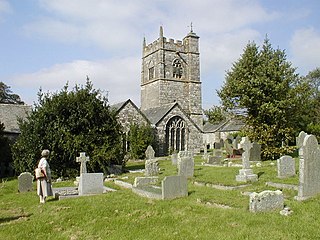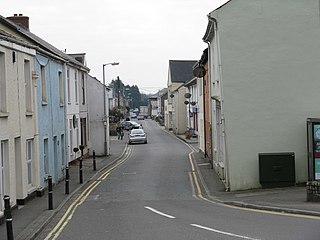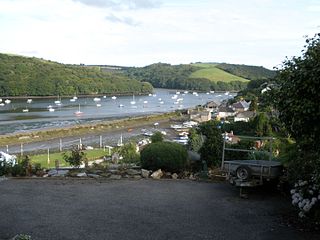
Samson of Dol was a Cornish saint, who is also counted among the seven founder saints of Brittany with Pol Aurelian, Tugdual or Tudwal, Brieuc, Malo, Patern (Paternus) and Corentin. Born in southern Wales, he died in Dol-de-Bretagne, a small town in north Brittany.

Tywardreath is a small hilltop village on the south coast of Cornwall, England, United Kingdom, about 3 miles (5 km) north west of Fowey. It is located in a sheltered spot overlooking a silted up estuary opposite Par and near the beach of Par Sands. It is on the Saints' Way path.

The Saints' Way is a long-distance footpath in mid Cornwall, England, UK.

Blisland is a village and civil parish in Cornwall, England, United Kingdom. It is approximately five miles northeast of Bodmin. According to the 2001 census, the parish had a population of 565. This had increased to 608 at the 2011 census.

St Blazey is a small town in Cornwall, England, United Kingdom.

Mullion is a civil parish and village on the Lizard Peninsula in south Cornwall, England, United Kingdom. The nearest town is Helston approximately 5 miles (8 km) to the north.

Lanlivery is a village and civil parish in Cornwall, England, United Kingdom. The village is about 1+1⁄2 miles (2.4 km) west of Lostwithiel and five miles (8 km) south of Bodmin. The Saints' Way runs past Lanlivery. Helman Tor, Red Moor and Breney Common nature reserves lie within the parish.

St Sampson is a civil parish in mid-Cornwall, England, United Kingdom. The population at the 2011 census was 260.

St Clement is a civil parish and village in Cornwall, England, United Kingdom. It is situated southeast of Truro in the valley of the Tresillian River. Other notable villages within the parish are the much larger Tresillian 1.4 miles (2.3 km) to the north east of St Clement village itself and another village at Malpas to the south of the parish. The urban part of the parish of St Clement was incorporated into Truro in 1895. The remainder of the parish had a population of 1,064 at the 2011 census.

St. Enodoc Church, Trebetherick is a chapel in the parish of St Minver. It is located to the south of the village of Trebetherick, Cornwall, England, United Kingdom. It is a Grade I listed building.

Herodsfoot is a village in southeast Cornwall, England, United Kingdom. It is situated approximately four miles (6 km) southwest of Liskeard and five miles (8 km) north of Looe at a point where two tributaries of the West Looe river join. It is in the civil parish of Lanreath

St. Barnabas' Church is a Church of England parish church in Erdington in the north of Birmingham, England.

St Uny Church, Lelant, is the Church of England parish church of Lelant, Cornwall, England. It is dedicated to Saint Uny who is also the patron saint of Redruth. It is a Grade I listed building.

Golant is a village in south Cornwall, United Kingdom. It is on the west bank of the River Fowey and in the civil parish of St Sampson.

Lanteglos is a coastal civil parish in south Cornwall, England, United Kingdom. It is on the east side of the tidal estuary of the River Fowey which separates it from the town and civil parish of Fowey. The South West Coast Path runs along the southern coasts of the parish and much of the southern part of the parish lies in the Polruan to Polperro Site of Special Scientific Interest managed by the National Trust.

All Saints Church is an Anglican parish church in the village of Crondall, Hampshire, England. It is a Grade I listed building and stands at the highest point in the village. Much of the church dates from the Norman period, although the original central tower was replaced by a brick one at the north-east corner in 1659 and some alterations, particularly to the fenestration, the nave arcades and transepts, and the north porch, were made in two stages during the 19th century.

Holy Trinity Church, St Austell is a Grade I listed parish church in the Church of England in St Austell, Cornwall.

St Gregory's Church, Treneglos is a Grade II* listed parish church in the Church of England in Treneglos, Cornwall.

St Protus and St Hyacinth's Church, Blisland is a Grade I listed parish church in the Church of England in Blisland, Cornwall, England, UK.

St Cyricius and St Julietta's Church, St Veep is a Grade I listed Church of England parish church in St Veep, Cornwall.























